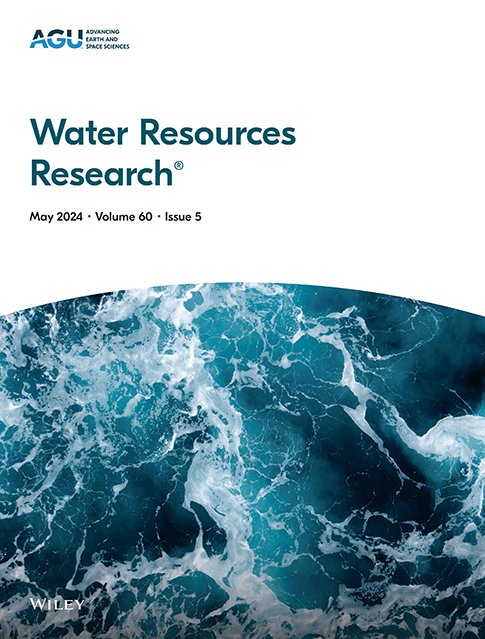将落基山流域不同岩性和土地覆盖梯度的地表过程、溶质生成和二氧化碳预算联系起来
IF 4.6
1区 地球科学
Q2 ENVIRONMENTAL SCIENCES
引用次数: 0
摘要
山区临界地带的化学风化作用控制着河流化学并调节着长期气候。山区地貌包含由地貌过程形成的各种地形,包括山体滑坡、冰川冰碛和岩石冰川。这些地貌形成了独特的流道和水岩相互作用,在降水转化为溪流的过程中改变了水化学。岩性和植被的变化也在很大程度上控制着水化学。先前的研究表明,在快速隆起的山脉中,山体滑坡会导致溶解溶质浓度增加。然而,不同的地貌过程和土地植被变化对不同构造和气候条件下溶质化学的影响程度仍存在不确定性。我们在科罗拉多河支流东河流域测量了地表水中的离子浓度,这些离子来自各种地貌的排水区域,并跨越了土地覆盖梯度。我们的结果表明,山体滑坡产生的溶质浓度高于在土壤覆盖的山坡上排水的溪流中测得的背景值,并且在山体滑坡发生数百年至数千年后,高浓度仍会持续。基岩切割活跃的河道也会产生较高的溶质浓度,而冰碛和岩石冰川排水中的溶质浓度与背景值相当。滑坡和基岩切蚀区域的溶质通量是附近土壤覆盖山坡的 1.6-1.8 倍。植被覆盖率较高的流域的地表水样本主要是碳酸风化。地貌增强的风化作用产生的二氧化碳净释放或螯合热点(取决于岩性)是背景值的 1.5-3.5 倍,这对了解高山流域地表过程、化学风化作用和碳循环动力学之间的联系具有重要意义。本文章由计算机程序翻译,如有差异,请以英文原文为准。
Linking Surface Processes, Solute Generation, and CO2 Budgets Across Lithological and Land Cover Gradients in Rocky Mountain Watersheds
Chemical weathering in mountain critical zones controls river chemistry and regulates long-term climate. Mountain landscapes contain diverse landforms created by geomorphic processes, including landslides, glacial moraines, and rock glaciers. These landforms generate unique flowpaths and water-rock interactions that modify water chemistry as precipitation is transformed to streamflow. Variations in lithology and vegetation also strongly control water chemistry. Prior work has shown that landslides generate increased dissolved solute concentrations in rapidly uplifting mountains. However, there is still uncertainty regarding the magnitude which different geomorphic processes and land cover variations influence solute chemistry across tectonic and climatic regimes. We measured ion concentrations in surface water from areas that drain a variety of landforms and across land cover gradients in the East River watershed, a tributary of the Colorado River. Our results show that landslides produce higher solute concentrations than background values measured in streams draining soil-mantled hillslopes and that elevated concentrations persist centuries to millennia after landslide occurrence. Channels with active bedrock incision also generate high solute concentrations, whereas solute concentrations in waters draining moraines and rock glaciers are comparable to background values. Solute fluxes from landslides and areas of bedrock incision are 1.6–1.8 times greater than nearby soil-mantled hillslopes. Carbonic acid weathering dominates surface water samples from watersheds with greater vegetation coverage. Geomorphically enhanced weathering generates hotspots for net CO2 release or sequestration, depending on lithology, that are 1.5–3.5 times greater than background values, which has implications for understanding links among surface processes, chemical weathering, and carbon cycle dynamics in alpine watersheds.
求助全文
通过发布文献求助,成功后即可免费获取论文全文。
去求助
来源期刊

Water Resources Research
环境科学-湖沼学
CiteScore
8.80
自引率
13.00%
发文量
599
审稿时长
3.5 months
期刊介绍:
Water Resources Research (WRR) is an interdisciplinary journal that focuses on hydrology and water resources. It publishes original research in the natural and social sciences of water. It emphasizes the role of water in the Earth system, including physical, chemical, biological, and ecological processes in water resources research and management, including social, policy, and public health implications. It encompasses observational, experimental, theoretical, analytical, numerical, and data-driven approaches that advance the science of water and its management. Submissions are evaluated for their novelty, accuracy, significance, and broader implications of the findings.
 求助内容:
求助内容: 应助结果提醒方式:
应助结果提醒方式:


